Category: Arts & Entertainment
Tulalip Tribes Annual Veterans Pow Wow, June 5-7
Sweeten the Easter Holiday With An Egg-Straordinary Buffet Brunch
Children can enjoy their very own kid’s knee-high buffet, featuring Mini Pepperoni Pizzas, Chicken Strips, Macaroni and Cheese Bites, and Mini Burgers.
This unforgettable brunch is priced at $40 inclusive for adults and $22 for children ages 4 to 12. Reservations* are highly recommended and can be made by calling 360-716-6888.
*Note: All reservations will have preassigned tables; each reservation will require prepayment at time of booking and is non-refundable; parties of 10 or more will be placed within close proximity of each other.
Native American Illusion Magic Show: Cherokee Secrets
Northwest Magician Launches his Illusion Magic Show
Sunday, 2:00 p.m. April 19 (Everett Civic Auditorium)
Press Release, Frank Dunn
Frank Dunn Magician is not your ordinary magician. Master Magician Frank Dunn has been performing magic ever since he got inspired as a child in the 1970’s with a magic set. Eight years ago he added his first illusion show to his stage magic, incorporating elements of his Eastern Band of Cherokee Indian heritage. He is an enrolled member of the Cherokee tribe. Frank also worked three years for the Native Arts and Cultures Foundation, supporting art for Native Americans nationally. While there, he got inspired by the arts of music, dance, theater, and, of course, traditional Native American artwork. “This particular illusion magic show I started with the story,” said Frank. “I wrote a Native American story about contemporary issues of being a Native American today in the 21st century, while pulling on some great historical stories of the Cherokee, like the story of good wolf verses bad wolf – whichever wolf you feed is the wolf that will win in the end. After I had a good story, I brought in the art of drums, totem poles, bow and arrows, pottery, and dance. Lastly, I added the illusions and magic that brought the story to life.”
“One of my goals was to create a show that almost anyone could connect with, even people with hearing loss or vision impairment. I am also very pleased to have helped a high school student, Jeff Lunde, with his senior project, called Magic. Jeff has been helping me build illusions, and I have been teaching him the art of magic.”
“I recently realized that the gift of magic I have been given has allowed me to break through to people of many cultures, from being invited to the East Indian Vedic Cultural Center to share magic and nan with them, to being invited into the Jewish, Lebanese, Chinese, Japanese, Hawaiian, many Native American tribal communities, as well as into the deaf community. I’ve seen magic delight people from so many cultures – and from ages 3 to 92! ”
Frank Dunn is, indeed, an uncommon and original magician.
Tickets for the Cherokee Secrets shows can be purchased online at: Frankhat.com, or at the door.
More information: Frank Dunn 1-800-890-4188
Email: frank_magician@yahoo.com
Download story at: www.frankhat.com/press
First Nations University of Washington 44th Annual Spring Pow Wow, April 10-12
Native Art Weekend March 27-29, Burke Museum
Seattle—“Culture is not stagnant. Through contact and the technological revolution, Tlingit culture is constantly adapting, observing, and searching for its place in the world,” said Alison O. Bremner, Tlingit artist.
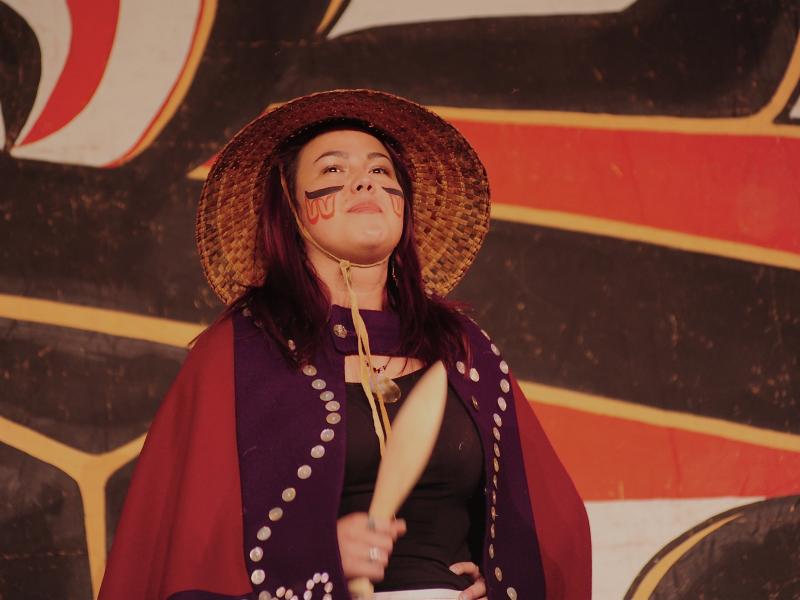
Photo by Steve Quinn
Bremner is one of 13 artists participating in the Burke Museum’s Northwest Native Art Marketon Sunday, March 29. Born and raised in Southeast Alaska, painting, sculpture, jewelry and digital collage are a few of the mediums she employs. In addition to her contemporary practice, Bremner is committed to the revitalization of Tlingit culture in her hometown of Yakutat, Alaska.
Presented in conjunction with the Here & Now: Native Artists Inspiredexhibit, the Burke is hosting a weekend-long celebration of Northwest Native art. Don’t miss this unique opportunity to purchase original works directly from artists. Also attend a two-day art symposium that brings together Native artists and scholars to discuss current trends in the distinctive art traditions of the region.
ArtShop: Northwest Native Art Market
Sunday, March 29, 10 am – 4 pm
Burke Museum
Included with museum admission; FREE for Burke members or w/UW ID
Don’t miss this unique opportunity to purchase original art directly from artists. The market will feature prints, jewelry, apparel, carvings, sculptures, and other works by 13 emerging and established Northwest Native artists. Art demonstrations including basket weaving, skinning and painting a drumhead, carving using traditional tools, and jewelry-making will be ongoing throughout the event.
100% of proceeds go directly to the artists.
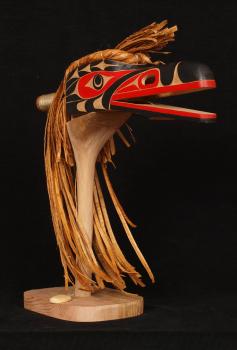
Photo courtesy of Alex McCarty.
Participating Artists:
Alex McCarty (Makah): Woodwork
Alison Bremner (Tlingit): Jewelry
Charles W Bloomfield (Pyramid Lake Paiute): Apparel
DeAnn Jacobson (Duwamish/Suquamish): Bead work
Israel Shotridge (Tlingit): Jewelry, woodwork, graphic design
Jason Reed Brown (Koyukon Athabascan): Metal work
Jennifer Younger (Tlingit, Kaagwaantaan): Jewelry
Joseph (wahalatsu?) Seymour, Jr. (Squaxin Island/Pueblo of Acoma): Drums
Linley Logan (Onondowaga AKA Seneca): Prints and cards
Lou-ann Neel (Kwakwaka’wakw): Jewelry
Mary Goddard (Tlingit): Woven Jewelry
Michelle Price (Navajo): Cedar vases
Roger Fernandes (Lower Elwha S’Klallam): Original paintings & design
Northwest Native Art Market Media Sponsor: KING FM.
ArtTalk Symposium: Conversations on Northwest Native Art
ArtTalk Keynote Program: We Got Styles!
Friday, March 27, 7 pm, Kane Hall 210, UW Campus
ArtTalk Symposium
Saturday, March 28, 9:30 am – 4 pm, Kane Hall 225, UW Campus
Both days: FREE; pre-registration recommended at burkemuseum.org/events
Join leading scholars and Native American/First Nations artists as they present recent research on Northwest Native Art. The symposium celebrates the 50th anniversary volume of Bill Holm’s influential book, Northwest Coast Indian Art: Analysis of Form. Speakers will examine the last 50 years of combining innovation and tradition, and envision the future of Northwest Coast art.
The weekend program will begin with the ArtTalk keynote. Dr. Robin K. Wright, director of the Bill Holm Center at the Burke Museum, will reflect on the study of Northwest Coast art styles and the remarkable things that have resulted from the interactions between Northwest Coast art scholars and artists over the past 50 years. She will be joined by Shaun Peterson (Puyallup/Tulalip artist) and David R. Boxley (Tsimshian artist) in a conversation about Northwest Coast art styles from their own experience, and what they foresee for the diverse mixture of rapidly expanding Northwest Coast art styles for the next half century.
Talks on Saturday will include topics such as collaborative research, community based scholarship, retrospectives on Northwest Coast art history, indigenous methodologies, and challenging pre-conceptions of contemporary Northwest Coast art.
For a complete schedule of talks and list of presenters, go to burkemuseum.org/events.
This symposium is made possible by support from the Walter Chapin Simpson Center for the Humanities, University of Washington.
CELEBRATE VALENTINE’S DAY: A MODERN DAY LOVE AFFAIR FROM ROMANCE TO ROCK
Tulalip Resort Casino Offers Sweethearts Multi-Sensual Dining Combined with Mesmerizing Music
Source: Tulalip Resort Casino
 Tulalip, Washington – Tulalip Resort Casino knows how to evoke the sensation of love. On Saturday, February 14th they will be joining forces to create a modern day romance of multi-sensual dining combined with mesmerizing music. Valentine‘s Day rock party includes a concert of tribute bands (“Heart by Heart” and “Rumors”) featuring music from legendary greats Heart and Fleetwood Mac. From 7-8:30pm in the Orca Ballroom, guests can savor a buffet dinner offering a selection of three salads, chicken or beef entrees, assorted desserts and coffee/tea. Admirers and their main squeeze can rock the night away to love pounding sounds starting at 9 pm.
Tulalip, Washington – Tulalip Resort Casino knows how to evoke the sensation of love. On Saturday, February 14th they will be joining forces to create a modern day romance of multi-sensual dining combined with mesmerizing music. Valentine‘s Day rock party includes a concert of tribute bands (“Heart by Heart” and “Rumors”) featuring music from legendary greats Heart and Fleetwood Mac. From 7-8:30pm in the Orca Ballroom, guests can savor a buffet dinner offering a selection of three salads, chicken or beef entrees, assorted desserts and coffee/tea. Admirers and their main squeeze can rock the night away to love pounding sounds starting at 9 pm.
This event for those 21 and over, offers a no-host bar and festival seating. Dinner and concert tickets must be purchased in advance and are priced at $60 per person or $100 per couple, including tax and gratuity. For those who wish to linger longer, show ticket packages (overnight deluxe accommodations, tickets for dinner and dessert, concert and breakfast at Eagles Buffet) are available starting at $350. To purchase Valentine’s Day “Rock Ballad Ball” tickets call (360) 716-6888 or for show packages, please contact reservations at 866-716-7162. Additional details can be found at Rock Ballad Ball.
Hightek Lowlives debut video for “Error Code 504″
By Tulalip News staff
Check out Hightek Lowlives debut video off record label Cabin Games, which is co-owned by Tulalip Tribal member, Brodie Stevens.
This is their debut video directed by Dave Wilson and released through the channels of Seattle EMP museum.
Hightek Lowlives includes vocalist/ songwriter Otieno Terry, winner of the 2014 EMP Sound Off!, and producer/ instrumentalist, Kjell Nelson.
Hightek Lowlives explore a variety of topics and issues throughout their music including ideas of love, human existence and artificial intelligence. By blending elements of the future and past Terry has developed the character Brother Damien, a humanoid with Artificial Intelligence from the year 2047, who has returned to our time to seek love and is a descendant of Otieno Terry.
Combing an array of sounds ranging from hip-hop, R&B, electronic and science fiction Hightek Lowlives are establishing themselves as a unique contestant in Seattle’s music scene.
NPR heavy weight Ann Powers describes their debut album, “Humanoid Void,” as one of the best break through albums of the year.
Cabin Games is owned and ran by former Sub Pop president Rich Jensen, and Up Records known for Built to Spill and Modest Mouse, as well as Tulalip Tribes tribal member, Brodie Stevens.
The Advocate: Tracy Rector
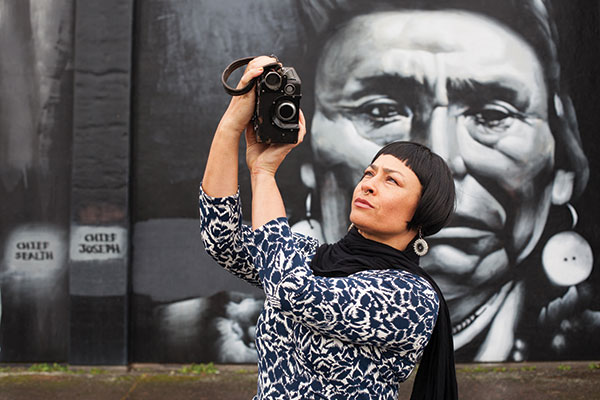
Last summer Tracy Rector spent three and a half weeks traveling 650 miles across the Salish Sea by canoe, recording the evolving relationship between tribal peoples of the Pacific Northwest and the waters they’ve called home for thousands of years. The journey was part of her forthcoming feature documentary, Clearwater, which Rector and co-director Lou Karsen started filming three and a half years ago.
Rector herself has Seminole roots, but she’s quick to outline the complexity of her identity. “I am French, Hungarian, Scottish, Irish, Choctaw, Seminole and African American. I identify as a Mixed Race Urban Native, more specifically. And I am a single mother of two amazing young men.”
In addition to filmmaking, Rector is co-founder and executive director of Longhouse Media, a nonprofit that documents the contemporary lives of Native people in the Puget Sound area. She’s a Sundance Institute Lab Fellow, a recipient for multiple awards in media and social justice, and serves on the Seattle Arts Commission.
“For me it’s not an option to be quiet,” she says.
Rector came to filmmaking circuitously. After burning out as a domestic violence advocate 14 years ago, she returned to school at Evergreen State College to study traditional medicine in the garden of a Skokomish elder, Gerald Bruce “Subiyay” Miller. While there, local filmmaker Katie Jennings approached Miller about documenting Miller’s life. He agreed— “’but only if a Native student can intern on the film, because our people need to learn the skills to tell our own stories,’” Rector paraphrases. “The door opened for me and I’ve been making films ever since.”
In 2008 she produced the coming-of-age documentary March Point, about three teenagers from the Swinomish reservation in northwest Washington. After running into trouble with the law and landing in drug court, the teens were offered the option to make a documentary, with the help of Longhouse Media, about the impact of oil refineries on their community. (It was the only Seattle documentary to be featured that year on the national PBS series Independent Lens.) Another of Rector’s documentaries, Unreserved: The Work of Louie Gong, about the Seattle artist and activist, screened in 2010 at Cannes.
With major support from PBS, Tribeca, Sundance and Washington Filmworks, Rector and Karsen will wrap up Clearwater this year and they’re planning a multimedia, interactive installation to coincide with the film’s release in January 2016. Rector will continue to program the “Indigenous Showcase,” a film series created in partnership with Northwest Film Forum, and is creating a new initiative with SIFF called 4th World to focus on Native content and to train youth and adult indigenous filmmakers, with additional support for female and LGBTQ indigenous artists.
Yet another one of her passions is Native Lens, a program hosted by Longhouse that provides education and technology to at-risk Native youth in both rural and urban areas. “My dream,” Rector says, “is to be a transformative force for good through art and arts activism.”
Age 42
Hometown Seattle
Current Obsession
The cosmic egg
Karaoke Song “Bump N’ Grind” by R. Kelly
Least Likely Influence Kwai Chang Caine
in Kung Fu
Skill You Wish You Had Playing the cello
– See more at: http://www.cityartsonline.com/articles/advocate-tracy-rector#sthash.u47GEHXI.dpuf
Native American Night Before Christmas: A New Old Tradition [Video]
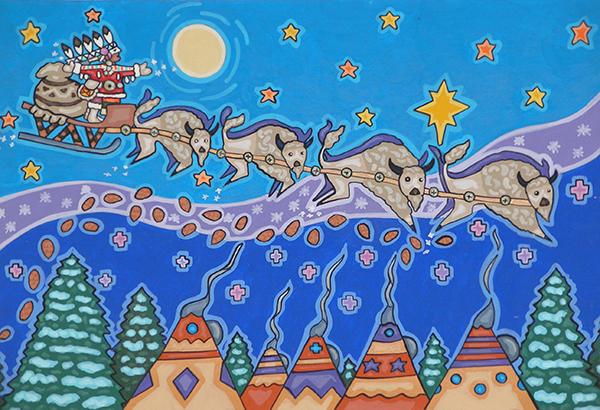
Illustration by Jesse T. Hummingbird from ‘Native American Night Before Christmas’
The reading of “A Visit From St. Nicholas,” a poem by Clement Clarke Moore better known by its first line, “Twas the Night Before Christmas,” is a tradition in many households; nearly 200 years after its first appearance, an author and an artist published a version that gave the story an American Indian flair.
Called simply Native American Night Before Christmas, the children’s book featured words by Gary Robinson (Choctaw and Cherokee) and images by Jesse T. Hummingbird (Cherokee). It was published by Clearlight Books, and was the Silver winner of the Moonbeam Children’s Award.
Here’s a short video of the poem, in which Old Red Shirt (Santa Claus) rides a sleigh pulled by bison and distributes frybread. It’s read by former Native America Calling radio host Harlan McKosato, with music by recent NAMA lifetime Achievement Award winner Jim Boyd. Gather round…
Read more at http://indiancountrytodaymedianetwork.com/2014/12/24/native-american-night-christmas-new-old-tradition-video-158444

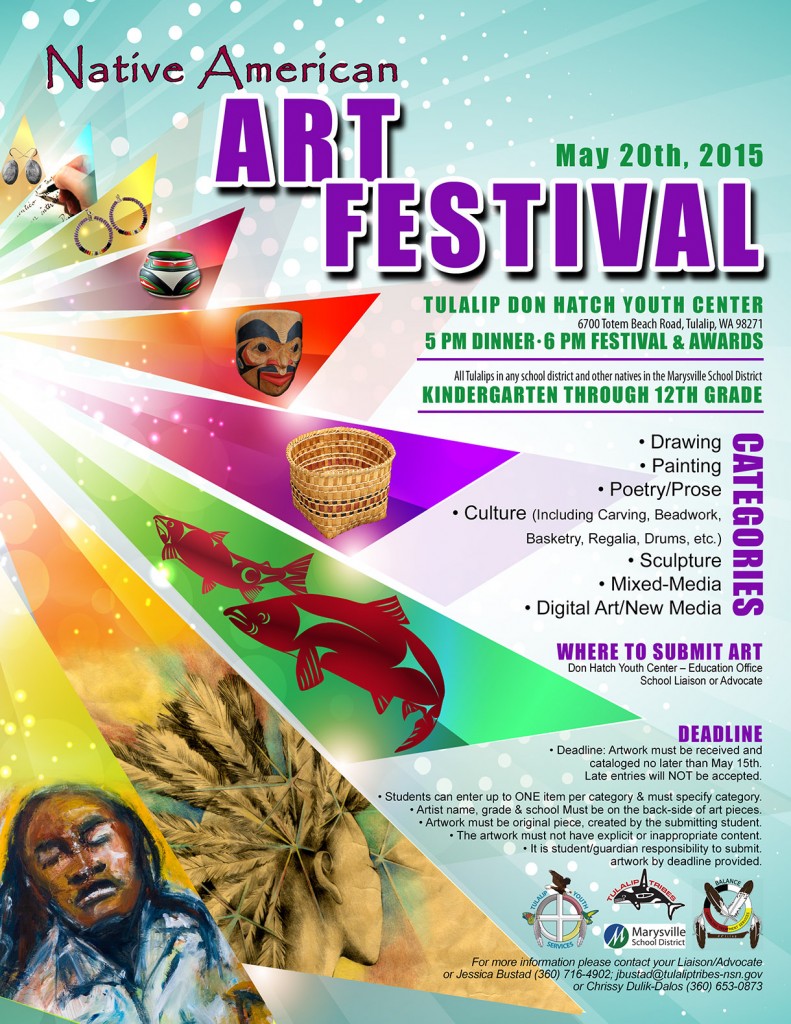






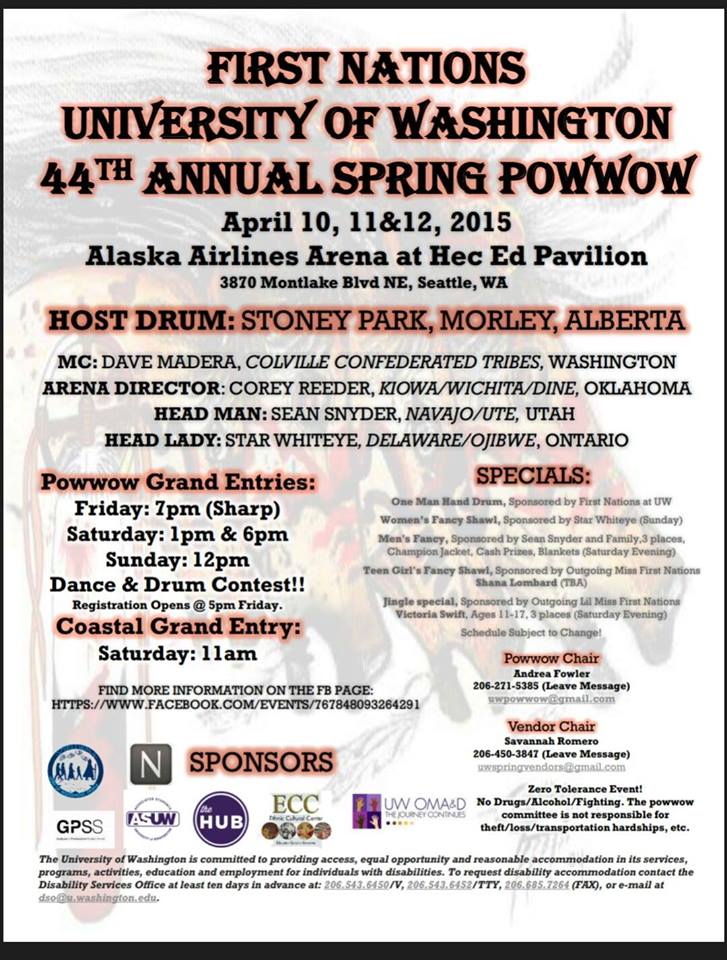




![Native American Night Before Christmas: A New Old Tradition [Video]](https://www.tulalipnews.com/wp-content/uploads/2014/12/native-american-night-before-christmas-jesse-t-hummingbird-50x50.jpg)